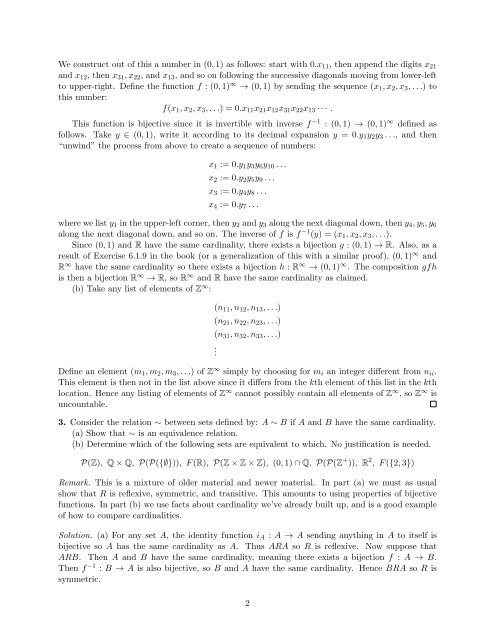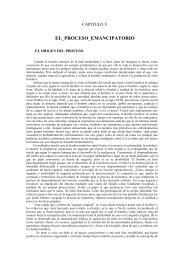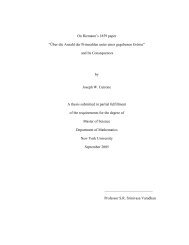Math 300: Final Exam Practice Solutions
Math 300: Final Exam Practice Solutions
Math 300: Final Exam Practice Solutions
You also want an ePaper? Increase the reach of your titles
YUMPU automatically turns print PDFs into web optimized ePapers that Google loves.
We construct out of this a number in (0, 1) as follows: start with 0.x 11 , then append the digits x 21<br />
and x 12 , then x 31 , x 22 , and x 13 , and so on following the successive diagonals moving from lower-left<br />
to upper-right. Define the function f : (0, 1) ∞ → (0, 1) by sending the sequence (x 1 , x 2 , x 3 , . . .) to<br />
this number:<br />
f(x 1 , x 2 , x 3 , . . .) = 0.x 11 x 21 x 12 x 31 x 22 x 13 · · · .<br />
This function is bijective since it is invertible with inverse f −1 : (0, 1) → (0, 1) ∞ defined as<br />
follows. Take y ∈ (0, 1), write it according to its decimal expansion y = 0.y 1 y 2 y 3 . . ., and then<br />
“unwind” the process from above to create a sequence of numbers:<br />
x 1 := 0.y 1 y 3 y 6 y 10 . . .<br />
x 2 := 0.y 2 y 5 y 9 . . .<br />
x 3 := 0.y 4 y 8 . . .<br />
x 4 := 0.y 7 . . .<br />
where we list y 1 in the upper-left corner, then y 2 and y 3 along the next diagonal down, then y 4 , y 5 , y 6<br />
along the next diagonal down, and so on. The inverse of f is f −1 (y) = (x 1 , x 2 , x 3 , . . .).<br />
Since (0, 1) and R have the same cardinality, there exists a bijection g : (0, 1) → R. Also, as a<br />
result of Exercise 6.1.9 in the book (or a generalization of this with a similar proof), (0, 1) ∞ and<br />
R ∞ have the same cardinality so there exists a bijection h : R ∞ → (0, 1) ∞ . The composition gfh<br />
is then a bijection R ∞ → R, so R ∞ and R have the same cardinality as claimed.<br />
(b) Take any list of elements of Z ∞ :<br />
(n 11 , n 12 , n 13 , . . .)<br />
(n 21 , n 22 , n 23 , . . .)<br />
(n 31 , n 32 , n 33 , . . .)<br />
.<br />
Define an element (m 1 , m 2 , m 3 , . . .) of Z ∞ simply by choosing for m i an integer different from n ii .<br />
This element is then not in the list above since it differs from the kth element of this list in the kth<br />
location. Hence any listing of elements of Z ∞ cannot possibly contain all elements of Z ∞ , so Z ∞ is<br />
uncountable.<br />
3. Consider the relation ∼ between sets defined by: A ∼ B if A and B have the same cardinality.<br />
(a) Show that ∼ is an equivalence relation.<br />
(b) Determine which of the following sets are equivalent to which. No justification is needed.<br />
P(Z), Q × Q, P(P({∅})), F (R), P(Z × Z × Z), (0, 1) ∩ Q, P(P(Z + )), R 2 , F ({2, 3})<br />
Remark. This is a mixture of older material and newer material. In part (a) we must as usual<br />
show that R is reflexive, symmetric, and transitive. This amounts to using properties of bijective<br />
functions. In part (b) we use facts about cardinality we’ve already built up, and is a good example<br />
of how to compare cardinalities.<br />
Solution. (a) For any set A, the identity function i A : A → A sending anything in A to itself is<br />
bijective so A has the same cardinality as A. Thus ARA so R is reflexive. Now suppose that<br />
ARB. Then A and B have the same cardinality, meaning there exists a bijection f : A → B.<br />
Then f −1 : B → A is also bijective, so B and A have the same cardinality. Hence BRA so R is<br />
symmetric.<br />
2





